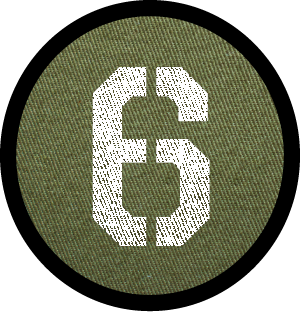
When World War II ended, the 92nd awarded many medals to the soldiers who served within the Division. However, none were awarded the Medal of Honor and only two, Lt. Vernon J. Baker of the 370th Infantry Regiment and Capt. Gilbert S. Holbrook was awarded the next highest medal, the Distinguished Service Cross.
It would not be until the 1980s when another soldier, Lt. John R. Fox of the 366th Infantry Regiment, would be awarded posthumously the Distinguished Service Cross due in part to advocacy from fellow veterans. In the 1990s, the U.S. Army commissioned Shaw University to investigate if systemic racial discrimination played a role in Black soldiers being denied the Medal of Honor during World War II.
After confirming that systemic racial discrimination did in fact prevent Black soldiers from being awarded the Medal of Honor, and recommended that ten soldiers receive the award. Seven would receive the Medal of Honor including Lt. John R. Fox and Lt. Vernon J. Baker. Only Vernon Baker would be alive to receive the Medal of Honor over fifty years after World War II ended.
Cuando terminó la Segunda Guerra Mundial, la 92.ª otorgó muchas medallas a los soldados que sirvieron en la División. Sin embargo, ninguno recibió la Medalla de Honor y sólo dos, el teniente Vernon J. Baker del 370.º Regimiento de Infantería y el capitán Gilbert S. Holbrook recibieron la siguiente medalla más alta, la Cruz por Servicio Distinguido.
No sería hasta la década de 1980 cuando otro soldado, el teniente John R. Fox del 366.º Regimiento de Infantería, recibiría póstumamente la Cruz por Servicio Distinguido, debido en parte al apoyo de sus compañeros veteranos. En la década de 1990, el ejército de los Estados Unidos encargó a la Universidad Shaw que investigara si la discriminación racial sistémica influyó en que a los soldados negros se les negara la Medalla de Honor durante la Segunda Guerra Mundial.
Después de confirmar que la discriminación racial sistémica de hecho impidió que los soldados negros recibieran la Medalla de Honor y recomendó que diez soldados recibieran el premio. Siete recibirían la Medalla de Honor, incluidos el teniente John R. Fox y el teniente Vernon J. Baker. Sólo Vernon Baker estaría vivo para recibir la Medalla de Honor más de cincuenta años después de que terminara la Segunda Guerra Mundial.
When the 92nd Infantry Division was disbanded on November 28, 1945, the men of the division returned to their families and communities. Multiple generations would feel their impact in various fields. Some of the members of the division, like MG Frederic E. Davison and MG James F. Hamlet would go on to command the 8th Infantry Division and 1st Cavalry Division in the 1960s and 1970s. Others like Capt. Edward Brooke and Charles A. Pratt would go on to serve as a U.S. senator for Massachusetts and a federal judge in the 8th District Court. Sgt. Ted Shearer would go on to create the comic strip Quincy. Many others would go on to become local leaders and advocates for their communities.
Cuando se disolvió la 92.a División de Infantería el 28 de noviembre de 1945, los hombres de la división regresaron con sus familias y comunidades. Varias generaciones sentirían su impacto en diversos campos. Algunos de los miembros de la división, como MG Frederic E. Davison y MG James F. Hamlet, pasarían al mando de la 8.ª División de Infantería y la 1.ª División de Caballería en las décadas de 1960 y 1970. Otros, como el capitán Edward Brooke y Charles A. Pratt, se desempeñarían como senadores estadounidenses por Massachusetts y jueces federales en el Tribunal del Octavo Distrito. Sargento. Ted Shearer crearía la tira cómica Quincy. Muchos otros se convertirían en líderes locales y defensores de sus comunidades.
There are many books written about the 92nd Infantry Division that cover the stories of the soldiers within the units as well as the impact of their military experiences. However, media covering the 92nd has, at best, been scarce due to popular culture’s whitewashing of the historical involvement of Black soldiers in military campaigns. As a result, the 92nd appears in only one major movie, Miracle at Saint Anna, directed by Spike Lee. In addition, the 92nd makes cameos in certain media, such as a playable faction for the U.S. Army in the video game, Day of Infamy.
Hay muchos libros escritos sobre la 92.a División de Infantería que cubren las historias de los soldados dentro de las unidades, así como el impacto de sus experiencias militares. Sin embargo, los medios que cubren el 92 han sido, en el mejor de los casos, escasos debido al encubrimiento por parte de la cultura popular de la participación histórica de los soldados negros en las campañas militares. Como resultado, el 92 aparece sólo en una película importante, Miracle at Saint Anna, dirigida por Spike Lee. Además, el 92 hace cameos en ciertos medios, como una facción jugable para el ejército de los EE. UU. en el videojuego Día de Infamia.
Tuesday–Saturday
10AM–4PM
Thursday
10AM–5PM
1PM – 5PM (Free Admission)
Sunday
Closed
Monday
Closed



